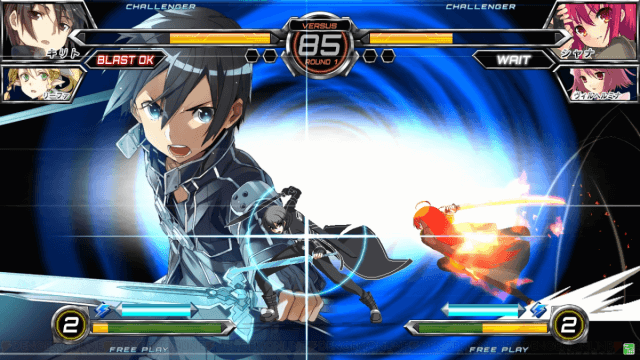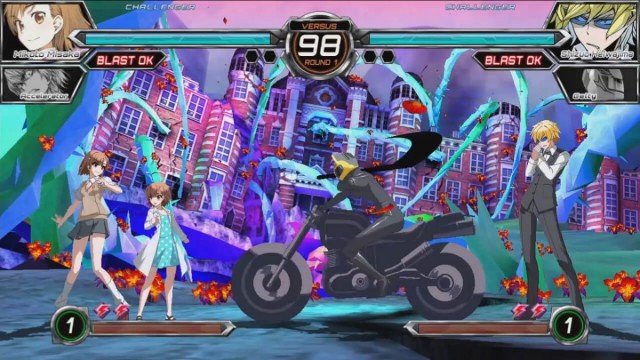Fanservice…Uhh…That’s All We Got
I’ve played many fighting games in my time, some of which were compilation games of different intellectual properties (see: Marvel vs series, vs SNK series, Tatsunoko vs Capcom.) However, the Anime Fighting Game scene hasn’t really seen anything of its sort, unless you want to count the two Persona 4 fighting games that released on Xbox 360 and PlayStation 3. Dengeki Bunko Fighting Climax, however, takes this to a “new” level, with a fighting game utilizing characters from the Dengeki Bunko imprint. Why do I place “new” in quotations? Largely because Tatsunoko vs. Capcom (or either the Super Famicom Dragon Ball Z Super Butouden series or the Bishoujo Senshi Sailor Moon fighting game if you want to play the technical card) introduced the idea of Anime characters into a fighting game setting.
Game Name: Dengeki Bunko Fighting Climax
Platform(s): PlayStation 3/PlayStation Vita (Cross-Save Functionality)
Publisher(s): Sega
Developer(s): French-Bread
Release Date: October 6, 2015 (North America)
Price: $39.99 (PS3); $29.99 (Vita)
That doesn’t take away from the aesthetics of Dengeki Bunko in any way, shape or form. However, this game does have it’s audience, and that’s not to say that it’s a bad thing. If you’re a fan of some or all of the light novel/anime/game series featured in this game, you’ll certainly get a kick out of playing this game, even if it’s just from a recreational standpoint. With playable characters such as Shizuo Heiwajima from Durarara!!, Kirito from Sword Art Online, and console exclusive characters Akira Yuki from Virtua Fighter and Selvaria Bles from Valkyria Chronicles, and their assists ranging from a series of Dengeki Bunko works, this game can certainly appeal to a wide audience, even if it’s a niche. But is the gameplay substantial enough? Can it attract the average gamer?
Dengeki Bunko (or DFC) is pretty much what you expect from any French-Bread fighting game that you can think of (Melty Blood/Under Night in Birth) when it comes to the way the game looks and feels. The stages are extremely vibrant, and the character sprites are extremely smooth and detailed. In terms of gameplay, however, much like from BlazBlue to Persona 4 Arena, the mechanics have been heavily simplified for even the most amateur of fighting gamers to pick up. Things like the auto-combo system (repeatedly press Square) make this game quite accessible, something that isn’t necessarily featured heavily in fighting games, even on the lowest stages.
Each character only has approximately 10 moves in their move-sets (including impact arts and supers,) with generally simple inputs such as quarter circle forward or quarter circle back plus an attack. Supers are performed using a half circle motion and two attack buttons, but that’s only the real tip of the iceberg with the game’s deceptively simple inputs.

The Assist System is also insanely useful, especially mid-combo, and is similar to the Striker system from KOF ’99 or assist characters from Marvel vs. Capcom. I can’t count how many times I’ve been saved by an assist, setting up a game winning or momentum shifting combo or moment. Your assists do have a cool down period, so you can’t go too crazy with them, but if you recognize your situations, they become an invaluable asset to you in tight situations.
Impact Breaks are somewhat of a mix between Persona 4 Arena’s All-Out Attack and Guilty Gear’s Dust button. Impact Breaks (back + AB(Square & Triangle)) have a hit of armor on them, so it’s easy to interrupt a move, and launches your opponent into the air, allowing you to extend your combo. Characters like Selvaria, Shana from Shakugan no Shana and Tomoka from Ro-Kyu-Bu can easily take advantage of this system, extending combos to a ridiculous amount, for others, though, it’s not so useful, but there are applications where this can work, so take the time to go into practice mode and discover.
The story mode is extremely lacking, in the sense that it’s a fairly pointless mode, with the only real goal being to unlock Akira, Pai, Alicia and Selvaria, and even then, it’s a fairly mundane and silly story about saving the dreams of the world from some hidden entity. It’s garbage, and you shouldn’t really waste your time outside of the unlocks of Akira and Selvaria.

Dream Duel is where this game really shines. Each of the arcade characters has their own special stories with 6 different battles. The stories aren’t “stories” per se, but the idea of Kirino Kousaka from Oreimo crossing over into the world of Sword Art Online and wanting to meet up with Kirito’s sister after hearing about her, or Kirito vs Asuna fighting for real is fun, as well as time-consuming. Overall, the mode should not take over 3 or so hours to finish, but you will gradually unlock characters in the special menu, allowing you to see some artwork related to the characters.
The game’s online mode is also pretty smooth. Over the last few days that I have been playing, I’ve only really gotten disconnected once, of no fault of my own. Getting a chance to play against players in Japan with little lag was fantastic before the American release, and ever since the release, finding matches hasn’t been a chore.
*Review copy provided by publisher
Is Dengeki Bunki Fighting Climax the price of admission?
Summary
As fun as Dream Duel is, Dengeki Bunko just isn’t worth the $39.99 that it’s being advertised for. The gameplay is mildly satisfying, however, that doesn’t make up for the lack of real variety in the game, outside of PvP matches. Story mode is god awful, and Dream Duel, while amazing, is short. Also, if you’re not a fan of fighting games, anime or both, this game serves no real purpose to you in the long run.
Pros:
- Gameplay is simple enough for a novice to pick up.
- Decent variety of characters.
- Online play is smooth and nearly lag free.
- Dream Duel is engaging.
Cons:
- Story Mode is lackluster.
- Not much in the way of content outside of the main story modes.
-
Graphics - 7/107/10
-
Sound - 7/107/10
-
Gameplay - 5/105/10
-
Replay Value - 3/103/10



